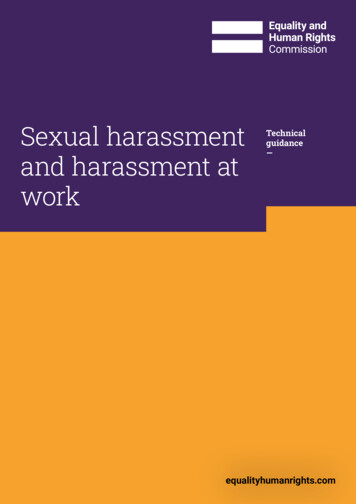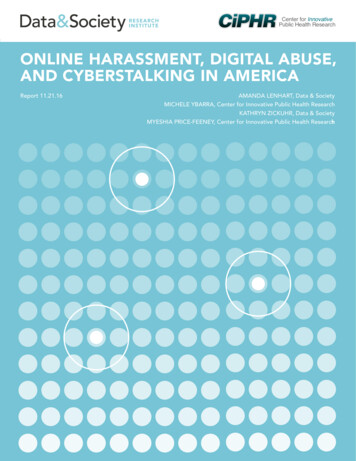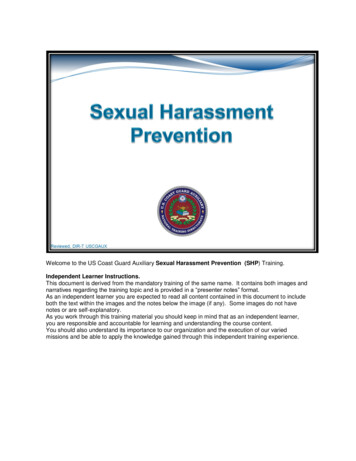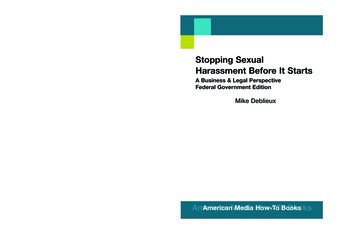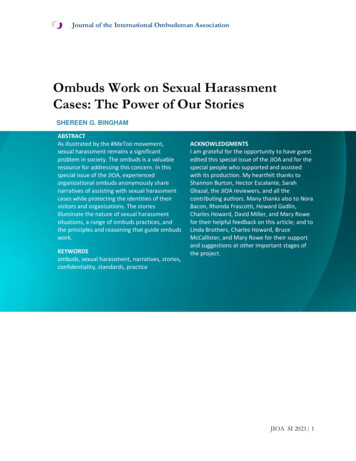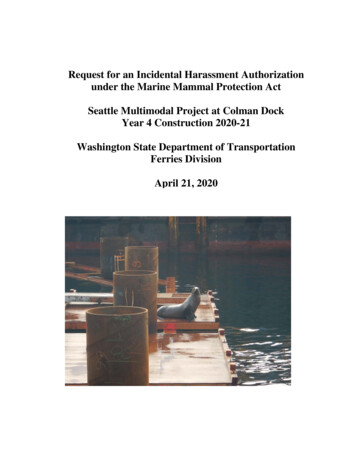
Transcription
Request for an Incidental Harassment Authorizationunder the Marine Mammal Protection ActSeattle Multimodal Project at Colman DockYear 4 Construction 2020-21Washington State Department of TransportationFerries DivisionApril 21, 2020
Submitted To:National Marine Fisheries ServiceOffice of Protected Resources1315 East-West HighwaySilver Spring, Maryland 20910-3226Prepared By:Washington State FerriesRichard D. Huey2901 Third Avenue, Suite 500Seattle, Washington 98121-3014206-515-3721hueyr@wsdot.wa.govCover: California Sea Lion hauled out on Colman construction platform (WSDOT 2018).
Table of Contents1.0Description of the Activity . 11.1Introduction . 11.2Project Setting and Land Use . 21.3Project Description . 21.4Regulatory Background . 51.5In-water Construction Details . 61.6Pile Driving and Removal Techniques. 81.6.1 Vibratory Hammer Driving and Removal . 81.6.2 Impact Hammer Installation . 91.7Sound Levels and Noise Analysis . 101.7.1 Source Levels . 101.7.2 Distances to Harassment Zones . 111.7.3 Shutdown Zones . 131.7.4 Airborne Reference Sound Source Levels . 161.7.5 Vibratory and Impact Pile Driving Airborne Noise . 172.0Dates, Duration, and Region of Activity . 202.1Dates . 202.2Durations . 202.3Region of Activity . 203.0Species and Numbers of Marine Mammals in Area . 223.1Species Present . 233.1Pinnipeds . 243.1.1 Harbor Seal . 243.1.2 Northern Elephant Seal . 253.1.3 California Sea Lion . 263.1.4 Steller Sea Lion . 273.2Cetaceans . 283.2.1 Killer Whale . 283.2.2 Gray Whale . 303.2.3 Humpback Whale . 313.2.4 Minke Whale . 323.2.5 Harbor Porpoise . 333.2.6 Dall’s Porpoise . 343.2.7 Common Bottlenose Dolphin . 354.0Status and Distribution of Affected Species or Stocks . 375.0Type of Incidental Take Authorization Requested . 395.1Incidental Take Authorization Request . 395.2Method of Incidental Taking . 396.0Number of Marine Mammals that May Be Affected . 416.1Estimated Duration of Pile Driving . 416.2Estimated Zones of Influence/Zones of Exclusion. 426.3Airborne Zones of Influence . 436.4Estimated Level B Takes . 436.4.1 Summary of Estimated Takes . 467.0Anticipated Impact on Species or Stocks . 48
Request for anIncidental Harassment Authorization8.0Anticipated Impact on Subsistence . 508.1Subsistence Harvests by Northwest Treaty Indian Tribes . 508.1.1 Harbor Seals . 508.1.2 California Sea Lions . 508.1.3 Gray Whales . 509.0Anticipated Impact on Habitat . 529.1Introduction . 529.2In-air Noise Disturbance to Haul Outs . 529.3Underwater Noise Disturbance. 529.4Water and Sediment Quality . 539.5Passage Obstructions . 549.6Conclusions Regarding Impacts on Habitat . 5410.0Anticipated Impact of Loss or Modification of Habitat . 5511.0Mitigation Measures . 5711.1 All Construction Activities . 5711.2 Timing Windows . 5811.3 Pile Driving BMPs . 5911.4 Pile Removal BMPs . 5911.5 Shutdown Zones . 6112.0Arctic Subsistence Uses, Plan of Cooperation . 6313.0Monitoring and Reporting Plan . 6513.1 Coordination . 6513.2 Visual Monitoring . 6513.3 Reporting Plan . 6614.0Coordinating Research to Reduce and Evaluate Incidental Take . 6815.0Literature Cited . 70Seattle Multimodal Project at Colman Dockiii
Request for anIncidental Harassment AuthorizationLIST OF TABLESTable 1-1 2017-2018 In-water Construction Completed . 6Table 1-2 2018-2019 In-water Construction Completed . 7Table 1-3 2019-2020 In-water Construction Completed . 7Table 1-4 2020-2021 In-water Construction Planned . 8Table 1-5 Summary of Source Levels . 11Table 1-6 Distances to Level A & B Zones/Level B Zones Areas . 12Table 1-7 Shutdown Zones . 13Table 2-1 Pile Driving and Removal Durations . 20Table 3-1 Marine Mammal Species Potentially Present in Region of Activity . 23Table 6-1 Durations . 41Table 6-2 Zone of Influence summary . 42Table 6-3 Zones of Exclusion/Shutdown . 42Table 6-5 Estimated Take Levels . 46Table 7-1 Level B Acoustical Harassment Take Request Percent of Total Stock . 48Table 11-1 Exclusion Zones . 61Seattle Multimodal Projectiv
Request for anIncidental Harassment AuthorizationLIST OF FIGURESFigure 1-1 Washington State Ferry System Route Map . 1Figure 1-2 Location of Seattle Ferry Terminal . 3Figure 1-3 Existing/Proposed Construction Elements . 4Figure 1-4 Vibratory Hammer Driving a Steel Pile . 9Figure 1-5 Impact Hammer Driving a Steel Pile . 10Figure 1-6 ZOI-1 24/36” Steel Vibratory . 14Figure 1-7 ZOI-2 14” Timber/12” Steel Vibratory . 15Figure 1-8 ZOI-3 36” Steel Impact . 16Figure 1-6 In-air construction noise threshold areas for pinnipeds . 18Figure 3-1 Pinniped haul outs in the Seattle project vicinity . 28Appendix AProject Sheets (Attached)Appendix BSeattle Multimodal Project Year One Acoustic Monitoring Report (Attached)Appendix CSeattle Test Pile Vibratory Pile Monitoring Technical Memorandum (Attached)Appendix DLevel A/B Distance Calculations (Attached)Appendix EMarine Mammal Monitoring Plan (Attached)Appendix FArcMap Map Package (Attached)Seattle Multimodal Project at Colman Dockv
Request for anIncidental Harassment AuthorizationAbbreviations and AcronymsBMPbest management de of Federal RegulationsdBdecibelsDPSDistinct Population SegmentDPSdynamic positioning systemEcologyWashington State Department of EcologyESAEndangered Species ActFHWAFederal Highway AdministrationFRFederal RegisterFTAFederal Transit AdministrationHPAHydraulic Project ApprovalHzhertzIHAIncidental Harassment AuthorizationIWCInternational Whaling )mmetersMATLABmatrix laboratoryMLLWMean Low-Low WaterMHHWMean High-High WaterMMmitigation measureMMPAMarine Mammal Protection Act of 1972NMFSNational Marine Fisheries ServiceNMMLNational Marine Mammal LaboratoryNOAANational Oceanographic Atmospheric AdministrationSeattle Multimodal Projectvi
Request for anIncidental Harassment AuthorizationNOAA/NMFSNational Oceanic Atmospheric Administration/National MarineFisheries ServiceNTUnephelometric turbidity unitsOHWordinary high waterOWCoverwater coveragePSAMPPuget Sound Ambient Monitoring ProgramPSDpower spectral densitiesPTSpermanent threshold shiftRCWRevised Code of WashingtonRLReceived LevelRMSroot mean squareSARStock Assessment ReportSELSound Exposure LevelSLSource LevelSPCCSpill Prevention, Control, and Countermeasures PlanSPLSound Pressure LevelSSVSound Source VerificationTLTransmission LossTTSTemporary Threshold ShiftµPamicro-PascalsUSFWSUnited States Fish and Wildlife ServiceWACWashington Administrative CodeWDFWWashington Department of Fish and WildlifeWSDOTWashington State Department of TransportationWSFWashington State Department of Transportation Ferries DivisionZOEZone of ExclusionZOIZone of InfluenceSeattle Multimodal Project at Colman Dockvii
1.0 Description of the ActivityA detailed description of the specific activity or class of activities that can be expected to result inincidental taking of marine mammals.1.1IntroductionThe Washington State Department of Transportation (WSDOT) Ferries Division (WSF) operatesand maintains 19 ferry terminals and one maintenance facility, all of which are located in theSalish Sea (Georgia Basin/Puget Sound) (Figure 1-1). Since its creation in 1951, WSF hasbecome the largest ferry system in the United States,operating 23 vessels on 10 routes with over 500 sailingseach day.To improve, maintain, and preserve the terminals, WSFconducts construction, repair and maintenance activitiesas part of its regular operations. One of these projects isthe Seattle Multimodal Project at Colman Dock, and isthe subject of this Incidental Harassment Authorization(IHA) request. This five-year project began in the fall of2017, under the first of five consecutive IHAs. Thisapplication addresses the fourth year of construction(August 2020 to mid-February 2021). If the fourth yearof construction goes well, it is possible that a fifth yearof in-water work, and a fifth IHA will not be necessary.The proposed project will occur in marine waters thatsupport marine mammal species. The Marine MammalProtection Act of 1972 (MMPA) prohibits the taking ofmarine mammals, which is defined as to “harass, hunt,capture or kill, or attempt to harass, hunt, capture orkill,” except under certain situations. Section 101 (a)(5)(D) allows for the issuance of an IHA, provided anactivity results in negligible impacts on marinemammals.The project’s timing and duration and specific types ofactivities may result in the incidental taking by acousticalharassment (Level A/B take) of marine mammalsprotected under the MMPA. WSDOT/WSF is requestingan IHA for 11 marine mammal species (Pacific harborseal, Northern Elephant seal, California sea lion, StellerFigure 1-1 Washington State Ferrysea lion, killer whale, gray whale, Humpback whale,System Route MapMinke whale, harbor porpoise, Dall’s porpoise, andcommon bottlenose dolphin) that may occur in the project vicinity.Seattle Multimodal Project at Colman Dock1
Request for anIncidental Harassment Authorization1.2Project Setting and Land UseThe Seattle Ferry Terminal at Colman Dock, serving State Route 519, is located on thedowntown Seattle waterfront, in King County, Washington. The terminal services vessels fromthe Bainbridge Island and Bremerton routes, and is the most heavily used terminal in the WSFsystem. The Seattle terminal is located in Section 6, Township 24 North, Range 4 East, and isadjacent to Elliott Bay, a tributary to Puget Sound (Figure 1-2). Land use in the area is highlyurban, and includes business, industrial, the Port of Seattle container loading facility, residential,the Pioneer Square Historic District and local parks.1.3Project DescriptionThe purpose of the Seattle Multimodal Project at Colman Dock is to preserve the transportationfunction of an aging, deteriorating and seismically deficient facility to continue providing safeand reliable service. The project will also address existing safety concerns related to conflictsbetween vehicles and pedestrian traffic and operational inefficiencies.Key project elements include: Replacing and re-configuring the timber trestle portion of the dock; Replacing the main terminal building; Reconfiguring the dock layout to provide safer and more efficient operations; Replacing the vehicle transfer span and the overhead loading structures of Slip 3; Replacing vessel landing aids; Maintaining a connection to the Marion Street pedestrian overpass; Moving the current passenger only ferry (POF) slip temporarily to the north to make wayfor south trestle construction, and then constructing a new POF slip in the south trestlearea. Mitigating for additional 5,400 square feet of overwater coverage; Capping contaminated sediments.The project will reconfigure the dock while maintaining approximately the same vehicle holdingcapacity as current conditions. The construction will take approximately five years, and began inAugust 2017. The terminal will continue to operate during the construction.The project will remove the northern timber trestle and replace a portion of it with a newconcrete trestle (Figure 1-3). The area from Marion Street to the north edge of the property willnot be rebuilt and after demolition will become a new area of open water. A section of fillcontained behind a bulkhead underneath the northeast section of the dock will be removed. WSFwill construct a new steel and concrete trestle from Columbia Street northward to Marion Street.Seattle Multimodal Project2
Figure 1-2 Location of Seattle Ferry TerminalSeattle Multimodal Project at Colman Dock3
Request for anIncidental Harassment AuthorizationFigure 1-3 Existing/Proposed Construction ElementsSeattle Multimodal Project4
The project will maintain the current King County Passenger Only Ferry (POF) functions on site,and address safety concerns related to pedestrian/vehicle conflicts at Yesler Street. A newcovered pier, sized to accommodate POF passenger waiting and connected by a new overheadpedestrian bridge to the terminal building and the Marion Street Overpass, will be constructedalong the south side of Colman Dock.The reconfiguration will increase total permanent overwater coverage (OWC) by about 5,400square feet (SF) (about 1.7% more than existing overwater coverage at the site), due to the newwalkway from the POF facility to Alaskan Way and new stairways and elevators from the POFto the upper level of the terminal. Removal of at least 5,400 SF from Pier 48, a condemnedtimber structure, will serve as mitigation for the permanent OWC increase.Construction of the reconfigured dock will narrow (reduce) the OWC along the shoreline (at thelandward edge) by 180 linear feet at the north end of the site, while 30 linear feet of new trestlewill be constructed along the shoreline at the south end of the site. The net reduction of OWC inthe nearshore zone is 150 linear feet.The project includes demolition of the existing terminal building and construction of a newterminal building. The new terminal building will be located along the west edge of the dock,spanning all three slips to handle passenger traffic more efficiently, and will connect to theMarion Street Overpass by an elevated deck.The project includes reconstruction of the vehicle transfer span and the passenger overheadloading (OHL) structures of Slip 3, including new hydraulic systems. The new OHL will bewider than the existing OHL, to accommodate the increased walk-on passenger volumes.Sediment beneath the terminal has been contaminated by the creosote-treated piles and otherchemicals discharged to the environment over the years. A cap was installed to covercontaminated sediment on the south half of the site prior to trestle expansion in 1990. WSF willplace a new sediment cap to the north and south of the current cap during construction of theproject to contain existing contamination. Stormwater management will be improved by theaddition of Filterra treatment units in the southern portion of the terminal, which will remove oiland suspended solids. Project sheets are provided in Appendix F.1.4Regulatory BackgroundThe effects of the project were analyzed pursuant to the National Environmental Policy Act andthe federal co-lead agencies, the Federal Transit Administration (FTA) and the Federal HighwayAdministration (FHWA), issued a finding of no significant impact (FONSI) on November 5,2015.During the NEPA process, the project underwent formal Endangered Species Act (ESA)consultation with National Oceanographic and Atmospheric Administration (NOAA) Fisheriesand the U.S. Fish and Wildlife Service (USFWS). NOAA Fisheries issued a Biological Opinionon March 20, 2014 and USFWS issued a Biological Opinion on February 18, 2014. A reinitiation of the project was completed in 2017. USFWS issued a Biological Opinion(01EWFW00-2013-F0262R001 X-Ref: OlEWFW00-2013-F-0262) on June 14, 2017 (USFWSeattle Multimodal Project at Colman Dock5
Request for anIncidental Harassment Authorization2017), and NMFS issued a Biological Opinion (WCR-2016-5803) on June 26, 2017 (NMFS2017a). A re-initiation for Humpback whale was completed on October 1, 2018 (BiologicalOpinion WCR-2016-5803)(NMFS 2018a).An Incidental Harassment Authorization (IHA) for Year 1 (2017-18) of the Seattle MultimodalProject was issued on June 8, 2017 (NMFS 2017b). A revised Year 1 IHA was issued on11/28/17 (NMFS 2017f). The Year 2 IHA (2018-19) was issued on 7/20/18 (NMFS 2018b). AnIHA application for Year 3 (2019-2020) was submitted on February 7, 2019. The Year 3 IHAwas issued on July 18, 2019. This application was submitted on April 21, 2020.1.5In-water Construction DetailsThis five-year project began in the fall of 2017, under the first of five consecutive IHAs. Thisapplication addresses the fourth year of construction (August 2020 to mid-February 2021). If thefourth year of construction goes well, it is possible that a fifth year of in-water work and a fifthIHA will not be necessary.In-water construction completed during Year 1 (2017-18) is provided below:Table 1-1 2017-2018 In-water Construction CompletedMethodPile typeTimberPile size(inch)14Season 1Planned215VibratoryremovalSeason 1CommentCompleted142Fewer present than estimated for Pier 2420Postponed until future ngVibratorydrivingSteel24101160Temporary piles. More needed thanplanned (24” piles removed are samepiles).Temporary piles (same piles removed).Steel30178Fewer needed.Steel36205275More needed than planned (36” pilesbelow noted as impacted are same es*Steel30148Fewer needed.Steel36201275More needed than planned.236291Seattle Multimodal Project6
In-water construction completed during Year 2 (2018-19) (numbers in parentheses totalquantity):Table 1-2 2018-2019 In-water Construction CompletedPermanent StructuresPermanent InstalledPermanent RemovedNorth Trestle(119) 36-inch steel(22) 12-inch steelSlip 3 Bridge Seat(8) 30-inch steel(925) 14-inch timber*Slip 3 Overhead Loading(6) 36-inch steel(19) 14-inch steel H*(1) 108-inch steel(35) 24-inch steelSlip 3 Wingwall(1) 30-inch steelSlip 2/3 Inner DolphinTemporary StructuresSlip 3 Overhead LoadingTemporary InstalledTemporary Removed(8) 24-inch steel(8) 24-inch steel(147) 24-inch steel(147) 24-inch steel*Deferred to Year 3In-water construction completed for Year 3 (2019-20):Table 1-3 2019-2020 In-water Construction CompletedPermanent StructuresPermanent InstalledPermanent RemovedSlip 2 Bridge Seat(8) 36-inch steel(1,046) 14-inch timber*Center Trestle(93) 36-inch steel(19) 14-inch steel H*Slip 2 WingwallExtension(2) 24-inch steel(2) 18-inch concrete(108) 12-inch steel(15) 18-inch steelSlip 2/3 Inner Dolphin(3) 36-inch steelTemporary StructuresTemplatesTemporary Installed(148) 24-inch steelTemporary Removed(148) 24-inch steel*Deferred from Year 2 (timber - 925 121 1,046)Seattle Multimodal Project at Colman Dock7
Request for anIncidental Harassment AuthorizationTable 1-4 2020-2021 In-water Construction PlannedPermanent StructuresNorth TrestlePermanent Installed(73) 36-inch steelPermanent Removed(355) 14-inch timber(30) 12-inch steelTemporary StructuresTemplatesTemporary Installed(30) 24-inch steelTemporary Removed(30) 24-inch steelYear 4 in-water construction methods include: Permanent 36-inch steel piles will be installed with a vibratory hammer, and then proofedwith an impact hammer for the last 5-10 feet. Permanent Removed - piles will be removed with a vibratory hammer. Temporary template piles will be installed and removed with a vibratory hammer (noproofing).1.6Pile Driving and Removal TechniquesProject vibratory hammer driving and removal, and impact hammer driving may affect marinemammals.1.6.1 Vibratory Hammer Driving and RemovalVibratory hammers are used to drive piles where substrate conditions allow, and are also used toremove piles. When pile driving, the pile is placed into position using a choker and crane, andthen vibrated between 1,200 and 2,400 vibrations per minute (Figure 1-4). The vibrations liquefythe sediment surrounding the pile allowing it to penetrate to the required seating depth, or to beremoved. The type of vibratory hammer that is being used for the project is an APE 400 KingKong (or equivalent) with a drive force of 361 tons.Seattle Multimodal Project8
Figure 1-4 Vibratory Hammer Driving a Steel Pile1.6.2 Impact Hammer InstallationImpact hammers are used to install piles, especially when substrate conditions are difficult(such as glacial till) or when proofing (gathering load bearing data). Impact hammers haveguides (called a lead) that hold the hammer in alignment with the pile while a heavy pistonmoves up and down, striking the top of the pile, and driving it into the substrate from thedownward force of the hammer on the top of the pile.To drive the pile, the pile is first moved into position and set in the proper location using achoker cable or vibratory hammer. Once the pile is set in place, pile installation with animpact hammer can take less than 15 minutes under good conditions, to over an hour underpoor conditions (such as glacial till and bedrock, or exceptionally loose material in which thepile repeatedly moves out of position). Figure 1-5 shows a pile being driven with an impacthammer.Seattle Multimodal Project at Colman Dock9
Request for anIncidental Harassment AuthorizationFigure 1-5 Impact Hammer Driving a Steel Pile1.7Sound Levels and Noise AnalysisUnder the NMFS Technical Guidance for Assessing the Effects of Anthropogenic Sound onMarine Mammal Hearing (Guidance) (NMFS 2016a), the calculation of Level A thresholds(permanent and temporary threshold shift) and Level B thresholds (harassment) are analyzed tounderstand the potential effects of in-water pile driving and removal noise on marine mammalsfor this project.1.7.1 Source LevelsThe source levels for impact pile driving of the 36-in steel piles are based on the Colman YearOne Acoustic Monitoring Report (WSDOT 2018). The highest source level was recorded for PileS19-SF: 174 SEL/188 RMS/206 Peak at 10 m.The source level for vibratory pile driving of the 36-in steel piles is based on vibratory test piledriving of 36-in steel piles at Port Townsend (WSDOT 2010a). Recordings of vibratory piledriving were made at a distance of 10 m from the pile. The results show that the unweightedSPLrms for vibratory pile driving of 36-in steel pile was 177 dB re 1 µPa.Seattle Multimodal Project10
The source level for vibratory pile driving and removal of the 24-in steel piles is based onvibratory pile driving of the 30-in steel pile at Port Townsend (WSDOT 2010a). The unweightedSPLrms source level at 10 m from the pile is 174 dB re 1 µPa.The source level for vibratory removal of 14-in timber pile is based on measurements conductedat the Port Townsend Ferry Terminal during vibratory removal of a 12-inch timber pile byWSDOT (WSDOT 2011). The recorded source level is 152rms dB re 1 µPa at 16 m from the pile,with an adjusted source level of 155 dBrms re 1 µPa at 10 m.The source level for vibratory removal of 12-in steel piles is based on vibratory pile driving of12-in steel pipe pile measured by CALTRANS (2015). The unweighted source level is 155 dBrmsre 1 µPa at 10 m.A summary of source levels is presented in Table 1-2.Table 1-5 Summary of Source LevelsMethodP
Protection Act of 1972 (MMPA) prohibits the taking of marine mammals, which is defined as to "harass, hunt, capture or kill, or attempt to harass, hunt, capture or kill," except under certain situations. Section 101 (a) (5)(D) allows for the issuance of an IHA, provided an activity results in negligible impacts on marine mammals.

